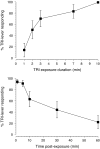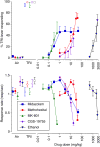Pharmacological classification of the abuse-related discriminative stimulus effects of trichloroethylene vapor
- PMID: 25202471
- PMCID: PMC4155754
- DOI: 10.4303/jdar/235839
Pharmacological classification of the abuse-related discriminative stimulus effects of trichloroethylene vapor
Abstract
Inhalants are distinguished as a class primarily based upon a shared route of administration. Grouping inhalants according to their abuse-related in vivo pharmacological effects using the drug discrimination procedure has the potential to provide a more relevant classification scheme to the research and treatment community. Mice were trained to differentiate the introceptive effects of the trichloroethylene vapor from air using an operant procedure. Trichloroethylene is a chlorinated hydrocarbon solvent once used as an anesthetic as well as in glues and other consumer products. It is now primarily employed as a metal degreaser. We found that the stimulus effects of trichloroethylene were similar to those of other chlorinated hydrocarbon vapors, the aromatic hydrocarbon toluene and the vapor anesthetics methoxyflurane and isoflurane. The stimulus effects of trichloroethylene overlapped with those of the barbiturate methohexital, to a lesser extent the benzodiazepine midazolam and to ethanol. NMDA antagonists, the kappa opioid agonist U50,488 and the mixed 5-HT agonist mCPP largely failed to substitute for trichloroethylene. These data suggest that stimulus effects of chlorinated hydrocarbon vapors are mediated at least partially by GABAA receptor positive modulatory effects.
Figures




Similar articles
-
Discriminative Stimulus Effects of Abused Inhalants.Curr Top Behav Neurosci. 2018;39:113-139. doi: 10.1007/7854_2016_22. Curr Top Behav Neurosci. 2018. PMID: 27714629 Review.
-
GABA(A) positive modulator and NMDA antagonist-like discriminative stimulus effects of isoflurane vapor in mice.Psychopharmacology (Berl). 2010 Dec;212(4):559-69. doi: 10.1007/s00213-010-1979-4. Epub 2010 Aug 10. Psychopharmacology (Berl). 2010. PMID: 20697696 Free PMC article.
-
Benzodiazepine-like discriminative stimulus effects of toluene vapor.Eur J Pharmacol. 2013 Nov 15;720(1-3):131-7. doi: 10.1016/j.ejphar.2013.10.036. Eur J Pharmacol. 2013. PMID: 24436974 Free PMC article.
-
Discriminative stimulus effects of inhaled 1,1,1-trichloroethane in mice: comparison to other hydrocarbon vapors and volatile anesthetics.Psychopharmacology (Berl). 2009 Apr;203(2):431-40. doi: 10.1007/s00213-008-1380-8. Epub 2008 Oct 30. Psychopharmacology (Berl). 2009. PMID: 18972104 Free PMC article.
-
Discriminative stimulus effects of ethanol: neuropharmacological characterization.Alcohol. 1999 Jan;17(1):63-80. doi: 10.1016/s0741-8329(98)00035-4. Alcohol. 1999. PMID: 9895039 Review.
Cited by
-
Stimulus mediation, specificity and impact of menthol in rats trained to discriminate puffs of nicotine e-cigarette aerosol from nicotine-free aerosol.Psychopharmacology (Berl). 2024 Aug;241(8):1527-1538. doi: 10.1007/s00213-024-06579-9. Epub 2024 Mar 23. Psychopharmacology (Berl). 2024. PMID: 38519818 Free PMC article.
References
-
- Balster RL, Cruz SL, Howard MO, Dell CA, Cottler LB. Classification of abused inhalants. Addiction. 2009;104:878–882. - PubMed
-
- Balster RL. Abuse potential evaluation of inhalants. Drug Alc Depend. 1987;19:7–15. - PubMed
-
- Bowen SE, Daniel J, Balster RL. Deaths associated with inhalant abuse in Virginia from 1987 to 1996. Drug Alcohol Depend. 1999;53:239–245. - PubMed
-
- Shelton KL, Balster RL. Inhalant Drug Discrimination: Methodology, Literature Review and Future Directions. In: Glennon RA, Young R, editors. Drug Discrimination: Applications to Medicinal Chemistry and Drug Studies. 1. Wiley; 2011.
Grants and funding
LinkOut - more resources
Full Text Sources
Other Literature Sources
